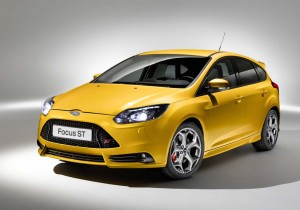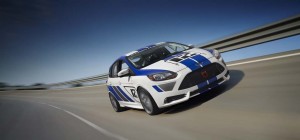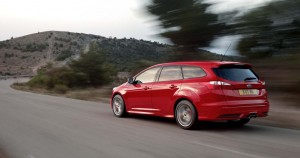The name SVT may be missing, but if the new Focus ST and Focus ST-R are any indication, Ford Motor Co. is getting serious about performance again, rather than limiting its muscle options to the likes of the Lightning pickup truck and Mustang pony car variants.
The two new offerings, which include the track-ready Ford Focus ST-R will make their long-anticipated debut at the Frankfurt Motor Show, this week, with Ford insiders hinting there may be even more in the works for the biennial event, the season’s largest European car show.
Significantly, the Focus ST underscores CEO Alan Mulally’s One Ford strategy, as it is the first of what the Detroit automaker can accurately bill as a “global performance car.” Others, it appears, are likely to follow. And there will be an emphasis on using higher-performance versions of Ford’s EcoBoost technology.
In the standard-issue Ford Focus, the 2.0-liter, inline-four twin-turbo engine puts the emphasis on fuel economy. With the Focus ST Ford shows the flexibility of the technology here adding some welcome muscle that bumps the horsepower count up to 250, while torque climbs to 250 lb-ft. The standard-issue 2012 Ford Focus makes 160 hp and 146 lb-ft.
The Focus ST’s EcoBoost engine will be mated to a 6-speed manual.
Along with the under-hood changes, the Focus ST gets a sport-tuned suspension that also lowers the ride height 10 millimeters.
There’s a variable-ratio steering rack and a rather intriguing new feature Ford calls “torque steer compensation.” Essentially, the system is designed to detect and counteract that annoying tendency to lurch to one side or the other normally experienced with high-output front-drive cars.
The Ford Focus ST will also integrate the Cornering Control found in products like the Taurus – which will slow the car down automatically if one enters a turn too fast – and Cornering Understeer Control.”
“We will establish in the U.S. a new benchmark for everyday performance,” boasts Jost Capito, head of Global Performance Vehicles and Motorsports Business Development.
From a more visual standpoint, the new Focus ST will come with sportier leather Recaro seats, unique grille and fascia, aluminum-finish pedals and shifter.
The Ford Focus ST will begin production in mid-2012 and should be in showrooms by early in the 2013 model-year.
This is the “next chapter” in Ford’s performance evolution, claims Capito, who notes that Ford is effectively dividing up its efforts into three categories:
- Enhanced Performance, with models like the new Focus ST;
- High Performance, with the Mustang GT 500;
- And Race-Inspired Performance, with models like the Focus ST-R.
“The Millennials consume motorsports differently” than past racing fans, says Jamie Allison, Director of Ford Racing. That’s led Ford to back a variety of new efforts, including drifting, to reach the next generation of buyers. Don’t take that lightly. Young consumers have traditionally steered clear of Ford and the rest of the domestic automakers, so such campaigns could be critical to rebuilding Detroit’s appeal.
The Focus ST-R is designed to give young enthusiasts a chance to get out and race without breaking their budgets. Stretching them a bit, perhaps, but while Ford won’t provide a price yet it insists the new model will be reasonably “affordable” for something that’s track-ready right off the truck.
“It’s a turnkey, off-the-shelf race car,” explains Allison.
Indeed, you’ll be able to order the Focus ST-R right out of the Ford catalogue as if it were a single performance part, here given the code FR200ST-R.
As with the Focus ST, the ST-R will make 250 hp, but it also gets a roll cage, upgraded brakes and suspension and Ford has taken steps – such as removing the carpet – to hold down on weight.
Ford is by no means the only maker putting an emphasis on performance these days. That might seem an oxymoron in an era of steadily increasing fuel economy regulations. The good news is that the industry’s best-and-brightest have discovered that technologies like direct injection and turbocharging can help them deliver both better mileage and improved performance.
And so, you can expect more to come. Capito notes that Ford now has 50 engineers dedicated full-time to performance vehicles. They aren’t expected to sit around and play video games. We just may see more in the coming days at Frankfurt.




